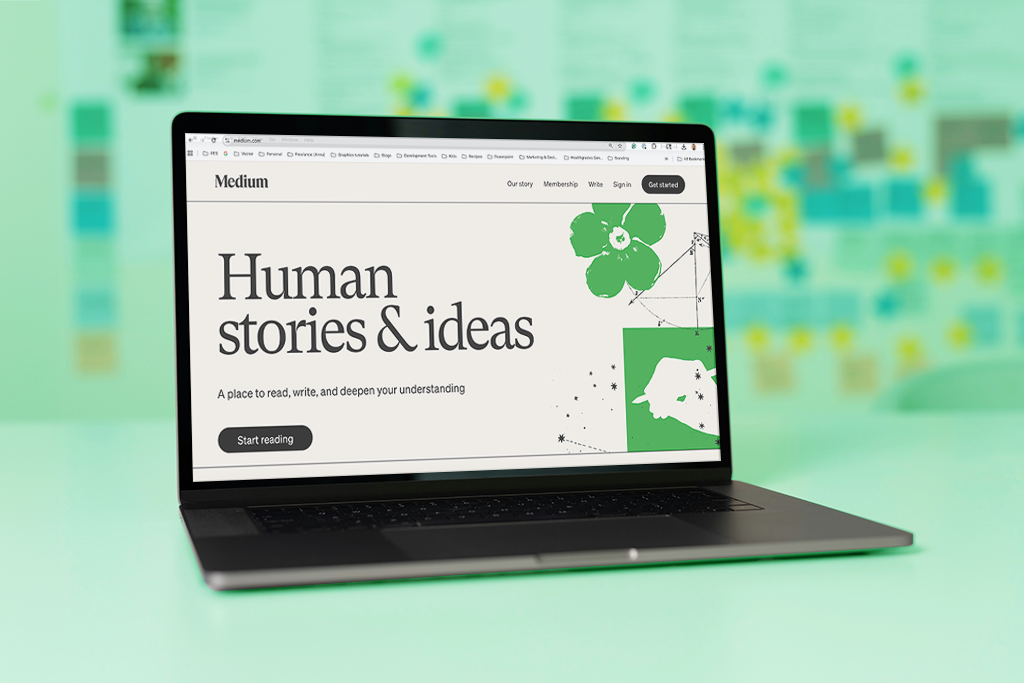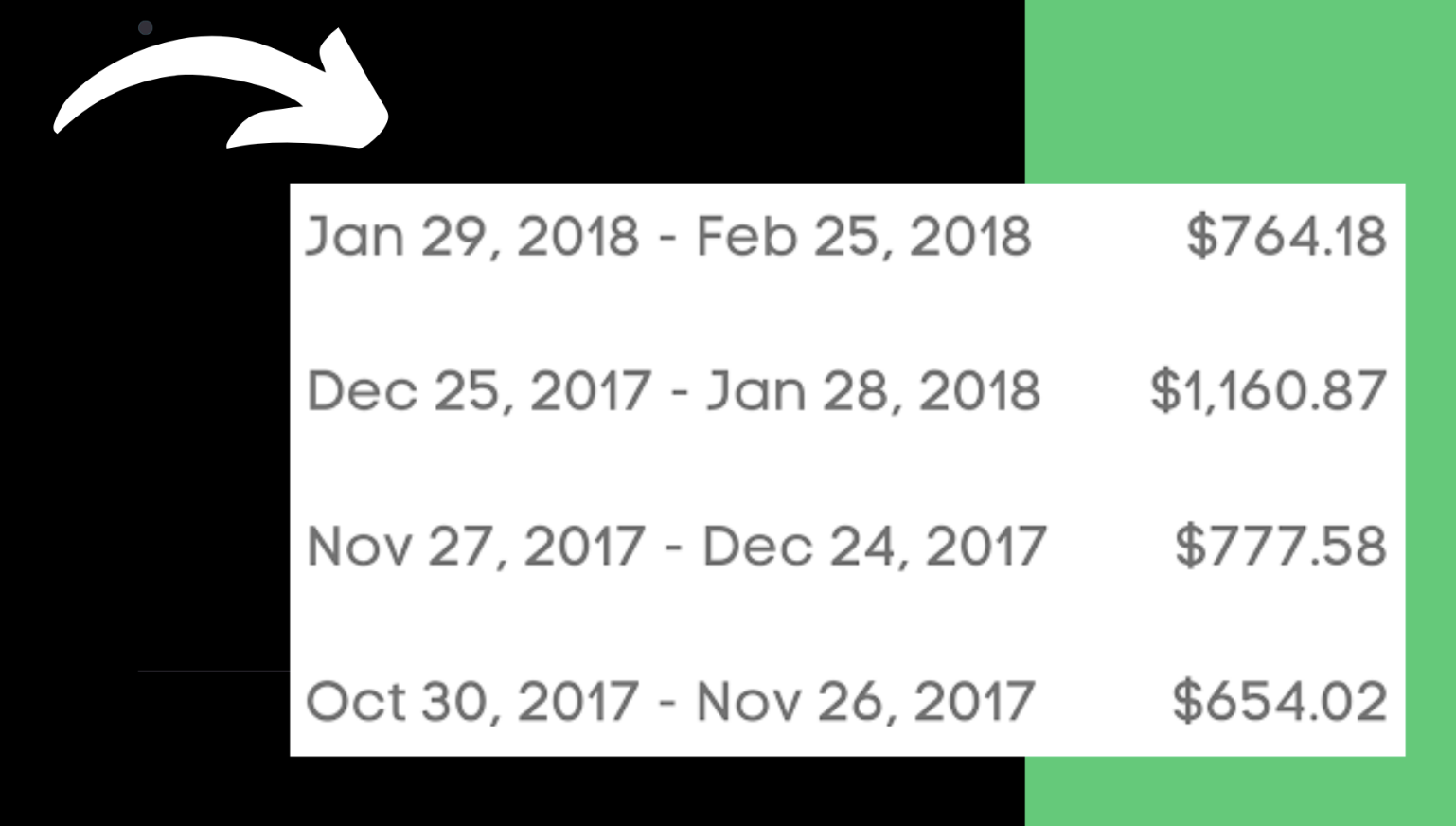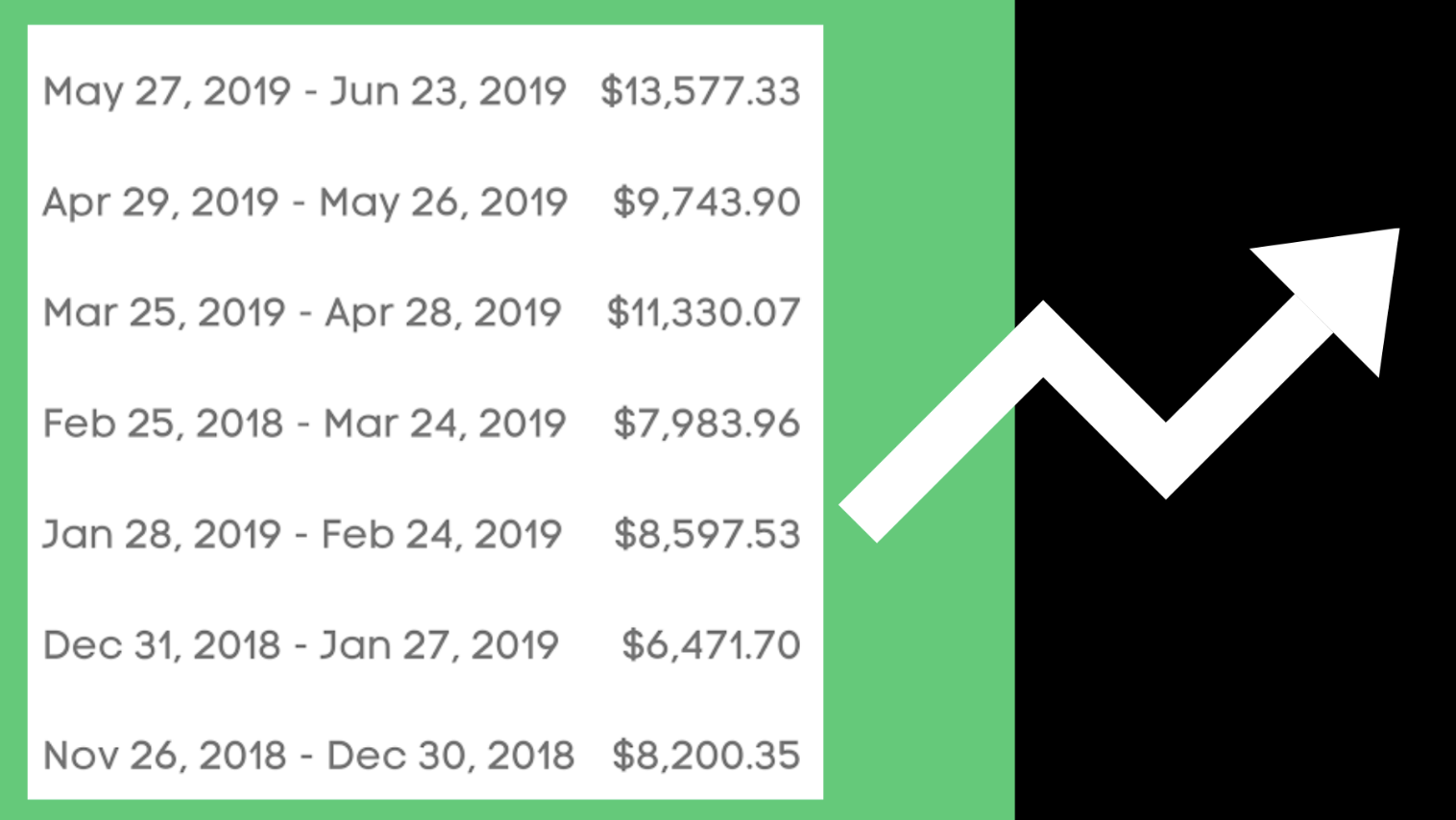
Income streams are the key to building a life of leverage, freedom, and autonomy. But there are so many ways to play it.
Should you have one core income stream and go all in on it, like a business?
Should you have multiple income streams?
There’s no correct answer to these questions. But it’s important to build a lifestyle where cash is coming into your account at a rate that helps you build a life you love.
The best way I can show you how to utilize different ways to make money is to show you how I did it.
I’ve used 7 different income streams to make $2,000,000 online. All of them played a part in where I am today, but as time went on, I filtered out the worst until I stuck with the best.
Here’s the entire list, ranked from worst to best.
7. Affiliate marketing: Great for beginners, but not your long-term play
I rank this income stream as the worst. Not because it’s a “bad” income stream. But because it’s one you never really own, and for me personally, it was nothing more than a passive way to earn here and there.
I started with affiliate marketing, throwing random Amazon links into my blog posts and hoping for the best. I made something like $30 one month and thought I was onto something. I wasn’t.
Most people approach affiliate marketing wrong. They promote products they’ve never used to an audience that doesn’t trust them yet. It doesn’t work.
I didn’t make real money with this income stream until I had already built an audience through my writing. People trusted my recommendations because they trusted me first.
I’d write these long-form articles about topics I genuinely cared about, and if there was a natural place to recommend a product that actually helped me, I’d include my affiliate link. No hard selling. No manipulation. Just honest recommendations.
I had some big wins selling some high-ticket products for commissions, like self-publishing school, which was one of the first online courses I bought. Still my favorite course to this day. It was easy to promote and push hard because the program changed my life.
I got paid $1,000 per sale by letting them host a webinar for my audience.
They gave me the messaging for emails to promote, ran the presentation, booked the sales calls, closed the deals, and I did nothing.
A $10,000 payout with zero effort. Not bad at all.
Affiliate marketing is great because it’s passive.
It’s also good for people who don’t yet have a product or service to sell. You can test out different products with your audience to see what they like, which can give you ideas for your own products down the road.
The downside?
The income fluctuates a lot. Products get discontinued. Companies change their affiliate terms. Google updates can tank your traffic overnight if you’re running affiliate products with SEO.
A business owner friend of mine dropped from $50,000 per month down to almost nothing because Google nuked his site, and all his eggs were in the affiliate basket.
That’s why I can’t rank it higher on this list. It’s nothing more than a nice beginner side hustle income stream unless you go all in with SEO or paid traffic.
6. Medium royalties: Close to my heart, but can’t trust the income
This was the income stream that helped me quit my job. It also led to building the audience that would become the foundation for my entire “mini-empire.” It’s the one that holds the most special place in my heart.
Let me take you back to November 2015.
I had been writing for a bit under a year at that point. I was always on the lookout for new places to post my articles because that was the thing to do to get ahead back then.
You’d publish guest posts on other big blogs or try to get your work featured on websites like Thought Catalog and Huffington Post that have huge platforms with a bunch of writers posting on them.
One day, I’m browsing Twitter and I come across this tweet:
Oh my God! My article just went viral on Medium!!!
“Hm…what’s Medium?” I thought. I immediately went to check the website, hoping to find another opportunity to get my name out there.
It was an interesting site. I read through a handful of articles from thoughtful, independent writers who were spilling their ideas on the screen in a way I hadn’t seen on other sites. It was cool.
I decided to post one myself.
Crickets. Zero views.
I was a bit discouraged, but I stayed on the website because there were all of these interesting articles to read.
Eventually, I noticed that the popular writers with all the views were posting inside “publications,” which were like mini-magazines inside the site.
Each of them had their own following of tens of thousands of readers, so if you put your work there, you’d get extra exposure.
I gave it a shot. I submitted an article to this publication called Life Tips, one of the biggest ones on the site.
It got rejected, but the editor gave me some feedback on why he rejected it and encouraged me to send another, which is what I did.
He accepted that one.
And that’s when everything started to take off. I was getting so many views on Medium that I abandoned all of the other websites I was writing for.
By 2017, I had about 10,000 followers. Then something crazy happened. Medium announced their “Partner Program.”
They started offering memberships for $5 per month for access to articles behind a pay wall. Writers could put their articles behind the paywall and earn money based on the engagement they got from members. I decided to give it a go. I made $225 the first month. Being broke at the time, I was quite happy with that result. The numbers crept up slowly:
I went all-in on Medium and the numbers kept growing:
It worked.
Like gangbusters.
Like, exceeding my expectations by 100X.
It was nuts.
I made $10,000 per month on Medium 17 months in a row, with a peak month of $21,963.96.
I made close to half a million dollars writing articles on the website.
Then, things started to take a turn.
They began making changes to the algorithm. My views started to drop. So did my income. Both fell by about 90% after all was said and done. I won’t get into details here, but Medium decided to make some changes to leadership that (in my opinion) ruined the company.
So while I did make a good chunk of $2 million from Medium, I can’t rank it too high on the list because of the earning potential this income stream has today:
- At best, you’re looking at $3,000-$5,000 per month if you take it seriously.
- The volume required to hit those numbers just isn’t worth the money. At my peak, I was writing 40 articles per month.
- You have next to no control over how much money you make, and the algorithm change can wipe away your earnings overnight.
Looking back, I got lucky. I caught lightning in a bottle. I was in the right place at the right time and early adopted a once-in-a-lifetime opportunity. In the end, it wasn’t sustainable, and I had to come up with more predictable income streams.
5. Freelance writing: Reliable and predictable
You can make a lot of money freelancing if you play it right. It’s one of the easiest ways to make money and most reliable income streams you can have.
Anyone can do it. There’s zero barrier to entry.
And it costs nothing to get started.
But most play it wrong, which is why they stay stuck.
Freelancing means you provide a service to a business in exchange for money. Usually, you’re selling the service to the business so that the business can make more money. Or, you’re spreading awareness for a business and educating their audience—so that they buy down the road.
Examples:
- Freelance writing (this is what I do)
- Paid advertisements
- Email marketing
- Design
- Web development
I’ve made multi-six-figures freelancing, mostly from inbound leads, meaning that these are opportunities that came to me.
I got really good at writing blog posts on Medium. Often, companies would find my writing on Medium and ask me if I would do it for them. I’d get referred to companies that needed someone to write for them, too.
In that way, I’ve been blessed. This isn’t a common experience for most freelancers. Most have to go out there and find their own work. I wouldn’t do much freelancing if I had to get leads myself because I’d rather be doing something else.
This is why freelancing is a great opportunity for beginner entrepreneurs. The best. But it’s the one most people avoid.
If you want to make a lot of money as a freelancer, you have to learn how to do out-bound marketing, which means you have to reach out to businesses and pitch your services to them via email or send direct messages on social media.
IMO, outreach is boring. You have to send a lot of messages to do it right (30-50 per day). And if you want to make the big bucks, you need to do clever and creative outreach, which almost no freelancer wants to do.
Take my world of freelance writing.
Often, freelance writers either wait for inbound leads or use job boards and freelancer platforms like Upwork.
You can find good gigs on these sites if you use a fine-toothed comb, but most of the gigs are for low pay, and you’re competing with other freelancers who will work for less, which drives down the price businesses will pay.
The way to find the best clients and make the most money looks like this:
- Get good at two skills: Blog post writing & SEO. Content writing and email marketing. Sales page copywriting and funnels. Having multiple skills means you can solve bigger problems for businesses, which means they will pay you more money.
- Send customized pitches: Take the time to research your prospects to figure out exactly what they need and send them a 2-3 minute video explainer that spells out how you’d help them
- Do so much volume, it would be unreasonable not to make money: I stole this from Alex Hormozi, who says if you want to grow your business, you should send 100 outreach messages per day, every day, until it works.
You can 100% quit your 9-to-5 job with freelancing. Do it to escape and build your passion project later.
4. Books: The simultaneously great and terrible product
I remember posting a tweet that said:
I want to write a book one day.
This was during college when I was spending most of my time skipping class—drinking often and doing everything I could to ruin my life.
Even back then, though, I always knew.
I knew that I would become what I am today: an author; a business owner; someone who would share their ideas, make an impact, and make a great income doing it.
The road twisted and turned a bit before I got here, but I got here.
I still remember the first time I got to look at a proof copy of my first book, “The Destiny Formula.” I rubbed my hand across the glossy cover. Opening the book and inhaling the new book smell that only nerds like me would appreciate. And most importantly, seeing my name on the cover.
I’ve published three books. When it comes to direct sales from the books, I have made roughly $100,000 directly from the sales of those titles.
Two things are true:
- Books are one of the worst ways to make money
- Books are one of the best ways to make money
You’re not going to get rich selling Kindle books for $4.99 and paperbacks for $19.99 unless you write a runaway bestseller like “Atomic Habits.” So books, as a direct way to make money, are a bad vehicle for making cash.
But the right book opens doors to opportunities and back-end revenue that has the potential to make you millions.
Books give you credibility.
Out of all the things I tell people about what I do, their eyes light up when I say I’m an author. It simply gives you this aura that can’t be matched by calling yourself an entrepreneur.
If you’re a coach, consultant, done-for-you service provider, or thought leader who writes a book, you can:
- Sell high-ticket products and services to implement what you taught in the book
- Land paid speaking engagements
- Get on podcasts that expose you to a bunch of new clientele
The right book is a sales asset. It’s one of the best ways to get people to know, like, trust, and buy from you.
Take me, for example.
Right now, my main product is a business coaching product.
But I can’t tell you how many clients and customers have told me they’ve read one of my books, which are all focused on personal development, not business.
I can’t even quantify how much back-end revenue and opportunities I’ve been able to make from my books, but I’m guessing it’s quite a bit.
I used to look at books the wrong way, as a poor vehicle to make cash, but now that I realize how much my books have contributed to the millions I’ve made. I’m writing my fourth one now.
Now, let’s get into the top three income streams. Each of these models is great for making money, but they have their pros and cons. The number one option offers the best of all the other models.
3. One-on-one coaching: High-ticket, low volume
If you have specialized knowledge in health, wealth, relationships, or self-improvement, some people will gladly pay you thousands of dollars to help them solve a specific problem or achieve a desired outcome.
One-on-one coaching is simple. You work with clients to help them solve their problems in exchange for money. This model works well for cash flow because you can charge so much for it.
Most coaches can charge $3,000 to $5,000 per client for a 90-day timeframe.
Depending on the niche and the problem, packages can go for $10,000, $20,000, or even $50,000 or more. The more I dive into the high-ticket coaching world, the crazier offers I see with insane price points.
If you can position yourself to the right person the right way and use your skills to solve the right problem, you can print cash.
I’ve made six figures from one-on-one coaching in different niches:
- Teaching writers how to build an audience and monetize on Medium
- Coaching entrepreneurs on packaging their skills into high-ticket offers
- Even doing life coaching in the self-improvement space
One-on-one coaching is great for fast, high-margin cash flow. It’s also the easiest way to validate your knowledge and prove that your offer works. You get direct feedback. You build social proof. You refine your process by working closely with real people.
Inside Words to Dollars, my coaching program for creators and business owners, I often recommend this model as a starting point because it’s the fastest path to landing your first few high-ticket clients.
You don’t need a big audience. You don’t need complicated funnels. If you post consistent content, send direct messages, and book sales calls, you can get clients within weeks instead of months.
There’s a downside, though.
Your income is still tied to your time. You’ll eventually hit a point where you’re maxed out.
Most students I’ve worked with can manage about five to ten active clients before burnout starts to creep in. Weekly calls, reviewing materials, replying to messages, and all the other tasks start to add up.
I stopped coaching people one-on-one for years because it just wasn’t enough of an ROI on my time to go through all the stress of managing and coaching people directly. Some people avoid coaching altogether and skip to this next model.
2. Online courses: Low-profit, high-volume
I made my first real business income selling courses online after making so much money on Medium.
People kept asking me to teach them how I did it. So I created a course breaking down my process, launched it to my audience, and it took off. That course earned $300,000 in revenue.
Later, I launched another course and community called The Writers’ League, which brought in another $300,000. I turned my third book, Real Help, into an online course and sold that for another five-figure launch.
From the outside, it looked like I had cracked the code. And in many ways, I had.
But there was a problem.
Even with two successful products under my belt, my income was stuck hovering around $20K per month because my pricing was too low, and I didn’t have enough traffic to move units at scale. I had built a solid business, but I couldn’t break past that ceiling without burning myself and my audience out.
There’s no denying the upside. If you have a system that works and you can teach it at scale, courses can bring in millions.
Build them once and can sell them forever. There’s no client delivery, no scheduling, no time-for-money trade-off like coaching. You can launch, automate, and generate consistent income for months or even years from a single offer. Selling courses while you sleep.
That said, courses come with some serious downsides that most people don’t talk about.
First, completion rates at around 3%.
That means 97% of your customers never finish the thing they paid for. As the creator, you win because you make money. But your students often lose.
And if you’re someone who cares about transformation, like me, it can start to feel hollow. Information doesn’t move the needle as much as support and implementation does.
Second, courses have a price ceiling.
Unless you have 100,000 followers or spend heavily on ads, it’s hard to scale course income beyond a certain point.
Last, to keep the cash coming, you have to launch several times per year. This means running promotions, writing endless email sequences, and creating urgency over and over again. It can work, but it can also burn out your list and wear you out in the process.
This last income stream, for me, has the best of both worlds. I can serve many clients, get them results, and charge high-ticket prices—all without having to sacrifice all of my time.
1. Coaching at scale
Adding this to my business helped me hit my first $75,000 month and my first year crossing $500,000 in revenue.
It’s the model I’m going to use to make a million this year.
Back up to March 2024.
I was hosting a virtual summit for the Writers League with two dozen guest speakers, some of the biggest names in our tiny corner of the internet.
It lasted 30 days and was a complete whirlwind. I was exhausted by the end of it.
Anyway, my coach, JK Molina, suggested I launch a high-ticket coaching offer to the writers in my community to help them build their offers and grow their businesses.
I didn’t think I was ready to be a “business coach.” I felt like I hadn’t earned it yet.
I remember a conversation I had a while back with another creator who suggested I get into business coaching. When I told him I didn’t feel credible enough he said:
Dude, you’ve made 7 figures online. That’s more than most other creators. If anybody deserves to teach it, it’s you.
With that conversation in the back of my mind and the nudge from JK, I launched Words to Dollars. It was $1,000 per month for access to a single one-on-one call, weekly group calls, and an online course embedded inside the mastermind. I opened up 12 spots and launched during the summit. They closed in 3 days. I launched again 2 weeks later with 10 spots. They closed in 4 days.
In a 30-day window, I signed 22 clients and added more than $20,000 in a monthly recurring revenue stream to my business.
This income stream and business model is powerful because it blends the best parts of every other model.
From online courses, you get scale and leverage. You can serve dozens or even hundreds of clients with the same foundational content, available 24/7.
From one-on-one coaching you get personalization. Clients feel supported, seen, and guided with feedback tailored to their situation.
From group coaching, you get momentum. People learn from each other, hold each other accountable, and stay engaged longer.
Since then, I have helped dozens of clients land their first clients and a handful have gone on to build their own coaching-at-scale models netting $20-40K per month, all within a year or less of starting their businesses.
That’s why this model is so potent. You can make it high volume and high cash flow at the same time.
Because coaching at scale delivers a hybrid of content, community, and access. Designed to deliver transformation and profit.
It’s also why I’m obsessed with this model.
You don’t need millions of followers. You just need a strong offer, a repeatable process, and a way to support people at scale.
This is the model I’ll be using for years to come. And if you’re a creator who wants to build a real business that doesn’t cap your income or burn you out, it might be the one for you too.
This might be the income stream you've been waiting for
The truth about income streams
They all work if you do the work.
Most people think the answer is in picking the right income stream, but it’s really in becoming the type of person that can make any income stream work.
The mechanics of making money are simple.
The biggest bottleneck is almost always the operator of the business. They’re held back by their own beliefs or character traits, so no tactics work.
Use these income stream ideas as inspiration. Go out there and make money doing whatever makes the most sense to you. Pick a lane. Go all in. Don’t stop until millions hit your bank account.















